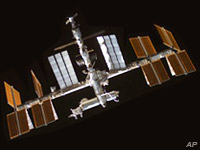
NASA and the European Space Agency have tested a prototype system that could truly give new meaning to long-distance calling. It could help enable Internet-like communications between Earth and other planets.

To demonstrate very long-distance remote control, ISS Commander Sunita Williams last month conducted an experiment using NASA’s Disruption Tolerant Networking (DTN) protocol to drive a Lego robot located on Earth at the European Space Operations Center in Germany.
Unlike other types of communication, DTN is not built around direct line of sight.
“The alternative means of communication is essentially direct line of sight,” said Kevin K. Gifford, Ph.D., of the University of Colorado’s Aerospace Engineering Sciences department.
“From there, you have a direct network. That means the Mars Rover needs to be on a particular side of Mars for someone on Earth to control it,” he explained.
Transmission Delay
While popular science fiction might suggest instant communication across the cosmos is possible, the truth is that it’s unlikely to occur anytime in the near future. Since direct line of sight occurs only when planets line up, an alternate technology is needed to solve the communications problem.

This is where DTN comes in — but it still won’t resolve the time-delay issue.
“For Mars, there is a minimum of eight minutes to communicate based on the orbit location,” said Gifford, who was part of the team at CU Boulder that worked with NASA to build the DTN network for the ISS.
“DTN is not going to overcome the speed of light, which is the fastest means of electromagnetic communications,” he pointed out.
Instead, it works by storing data at intermediate nodes, such as a satellite, until a downstream communication channel is available. This allows the communication to sidestep the line-of-sight requirement for connecting data, which is in essence an all-or-nothing option. With line of sight, the information either gets through or it does not.
DTN technology sends information a relatively short distance, where it can be stored, and then sends again when a communication channel opens up.
“It is a little like a basketball as you are moving the ball towards the goal, and a player can wait to pass the ball,” Gifford told TechNewsWorld. “Anytime there is not a direct path, the ball can be held in place. This makes it more efficient for communicating over long distances.”
Outer Space Networking
The technology would of course limit real-time communications — but then again, even direct line of sight can’t overcome the eight-minute delay between Earth and Mars, for example. Taking that into account, DTN could be more like email than instant messaging.
However, it has other advantages as well.
“Think of this technology as ultra-high latency and ultra-reliable,” said Rob Enderle, principal analyst of the Enderle Group.
“It is designed to function where no other networking technology could function. It uses a lot of prediction and redundancy to compensate for the problems it is designed to solve, and it drives a lot of intelligence into the network,” he told TechNewsWorld.
It could be used to keep information running and communication going, albeit slowly, even in situations when normal networks might have failed catastrophically.
“This is on the evolutionary path to communications technologies used for space exploration and it’s ideal for warfare — and Defense is likely the biggest funding source for it,” Enderle said.
“It could also mitigate problems associated with storm-damaged networks, which is topical at the moment; networks in emerging countries, which aren’t very reliable; networks that are under cyberattack; and networks that are failing for other reasons,” he suggested.
DTN for First Responders
Because it has the ability to be a backup system of sorts when other networks might go down, DTN is also being integrated within emergency networks.
“This is the national public safety broadband network, which was funded in March of this year,” said Gifford. “It provides (US)$7 billion to upgrade the U.S. first responder network.”
DTN could enable communications if existing networks should fail or become inaccessible. Data could be transmitted to various nodes, held until communications were restored or accessed, and the information could then be passed on.
DTN will be optimized through the commercial infrastructure in the event of an emergency Gifford added. “It has direct applications for the public safety network.”





















































